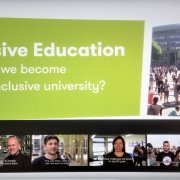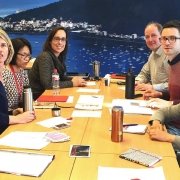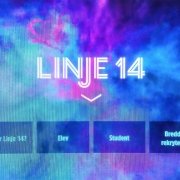Din Röst Ska EKA!/ Your voice shall echo
Excerpt
This project is about the social dimension of education and aims at strengthening schools in how to deal with challenging behavior among students, and also to empower young people, giving them tools to influence their future. If a school experiences problems and some kind of challenging behavior, they contact The Pedagogical Center in the city Malmö and a meeting is set up to “explore, learn and solve”. After listening to the school's descriptions and mapping their problem, a plan of action is suggested and discussed with the school. All activities are tailor made for each school and situation with the overall aim that every child should reach their full potential and that their voices should echo.
Narrative, origins and objectives of the initiative
What kind of project is this? Please give a short description (summary) of it.
Your Voice Shall Echo is about the social dimension of education and aims at strengthening schools in how to deal with challenging behavior among students, and also to empower young people, giving them tools to influence their future. Through tailor-made workshops, interventions and other activities for teachers, student health teams and other groups of staff within school, as well as for students, the project empowers the participants and provide them with tools to deal with challenging behavior.
Please tell us why, in general, this project is considered a successful one?
Because the project offers something the city can’t. The project leaders can add perspectives and experiences that are not so visible within traditional education. These project leaders share an experience with the young people in vulnerable and deprived areas and can therefore act as role models.
And why would you consider it a grass-roots initiative?
It was a true grassroots initiative: The two initiators (now the project leaders) started the project on their own without any support. They created this model as an answer to what they would have needed as young boys.
What challenges needed to be solved in this project?
This project addresses three main challenges:
- How to empower young people to take responsibility for their own future
- How teachers can create inclusive learning environments
- How to handle challenging behavior
Is this initiative based on any particular theoretical framework? Which one?
Relational pedagogy, developmental psychology and neuropsychology.
(Appendix) Is your intervention standing on its own or is it a part of a bigger and more holistic approach?
Not at first, but after two years the two project leaders are employed by the city and Your Voice Shall Echo is part of the city of Malmö strategy for primary education: "The best school for each student". The way of working that has developed through the project fits very well with this strategy.
Please describe the group(s) intended as beneficiaries of this initiative
Why has this group (have these groups) been chosen?
The main target group is teachers in primary and secondary schools in Malmö. Indirectly the young people of Malmö benefit from the initiative. The direct target group are chosen because of the important role education plays in order to reinforce young people's confidence and make them want to take their place in society.
Could you please tell us something about the relative size of the (of each) target group, within the school/university population, region and/or country?
Your Voice Shall Echo focus mostly on the teachers in Malmö. There are around 100 primary and secondary schools in the city. The number of employees in the school organisation is 5 600: the majority are teachers. So far the project has reached 1 563 teachers/staff and 4 112 students.
Which social characteristics are taken into account and what is the geographical area covered?
Your Voice Shall Echo works across the country (Sweden) but focus mostly on Malmö: Malmö is the third largest city in the country with a population of 320 000, out of which 1/3 is foreign-born. The city’s inhabitants come from around 170 countries and speak around 150 different languages. Half of the inhabitants are younger than 35 years old. It is a segregated city that is known both as a city with a striving knowledge-based economy and as a city with deprived areas and gang criminality.
On which level is the project implemented?
At municipality level.
Please describe the political and socio-economic factors that you believe have been important enablers for your initiative
Did the initiative have political support?
Not at first, bur after two years the project leaders are employed by the city, which is politically controlled.
How did it fit with local, regional or national policies?
The city of Malmö has an outspoken goal to ensure that all residents feel involved and included and the working methods of this project fit very well with this strategy.
Who are the stakeholders supporting the initiative?
The City of Malmö (Malmö stad).
Are there particular demographic changes present that are influencing the project?
Not directly but the average age of a Malmö citizen has dropped by three years in the last two decades and the typical resident today is a 28-year-old woman or 30-year-old man. The predominance of this age group also means that the city has a high ratio of children under the age of six. One explanation (among others) is the influx of refugees.
What is the institutional strategy and culture of the (educational) organization?
An overall aim is to ensure that Malmö’s residents feel involved and included. This is carried out in the daily work in schools as a strategy for "the best school for each student".
To what extent does the initiative have an influence on institutional policy (or potential influence) of the (educational) organization?
This initiative has made it visible for the city that there is a need for this type of work and it is now a well established part of the city’s work in schools.
(Appendix) Is there public support for your initiative and the issue it addresses?
Yes, and there is a medial interest: a number of newspapers and TV programs have reported about this.
(Appendix) What other factors do you think have been important for the success of this initiative?
The fact that the project leaders have experienced some similar challenges as the children make them credible. Because they have managed the challenges, they can serve as role models. The project leaders' attitude and way of working: "We don’t respect boundaries, we don’t take no for an answer. Hard work and belief!" is also an important factor.
Please describe the overall initiative design and the methods and tools used to reach the goals
Please describe the specific activities carried out.
[embed]https://vimeo.com/114274980[/embed]
Within this project they have developed a method of their own approach to face the challenges by acting preventive and by using a health supporting perspective, which works to solve conflicts when they occur. They help kids who show a need for training cognitive and social skills and they also develop the teacher's skills so that all kids can benefit from this and reach their full potential. They work in a workshop format and tailor each workshop to meet a specific need.
What were the key roles (teacher, student, management team etc.) within the project?
- The project leaders (one social worker and one social pedagogue)
- A team of 7 ambassadors
- Teachers
- Student health services, counselors, psychologists etc.
What ideas, tools, theories, models, methodology (etc.) have been used to reach the goals?
Relational pedagogy, social and psychological theories, and management methodology. Within this framework the project has developed a method called BVS (in Swedish), which they will launch 2019.
What are the final revenues of the project?
It's ongoing.
Please describe if your project ensured its sustainability
If so, how did you ensure the short-term impact of the project?
They identified a need and addressed it by developing their method - based on their own experiences. Because they delivered good results, the city has bought into their skills and model, which gives good conditions for sustainability.
And how did you ensure the long-term impact of the project?
Their methods has now been developed in a more theoretical sense and they have connected the project to the city's regular organization as a part on the Center for Pedagogical Inspiration.
Has your project been replicated elsewhere?
Not that they know of. They have made attempts to spread it to other cities. It is easy to replicate because of the clear method.
Please tell us about the resources used in this initiative
What was the budget for the initiative?
There was no budget at first. Now the city is paying about 6000 euros a month. The city also covers the costs for the time for competence development for the teachers and other staff. This is however not an extra cost but part of the budget for schools.
How much did the initiative depend on volunteers?
Very much: In the beginning two persons invested their own time and energy for this project. This project would not have started without that big investment of unpaid hours.
How were the costs perceived by the public/the sector/other stakeholders?
As reasonable.
To what extent did the initiative achieve its objectives?
Please describe the evidence to support the success of your initiative.
- Answers in questionnaires show that there is a large majority of teachers who have been helped and developed tools to deal with difficult behaviour and how to empower children.
- Kids are performing better in their classes.
- There is an increasing demand of workshops.
- The fact that the project is now part of The Center for Pedagogical Inspiration is an evidence of success in itself.
Did the intervention lead to any unintended (positive) outcomes?
Yes, the teachers also got to know each other better and that resulted in better working environments for them and for the kids.
What indicators (quantitative and qualitative) have you measured to demonstrate success?
Student success (quantitative) and teacher reports on their new teaching methods and the results of that (qualitative).
(Appendix) How did you evaluate/monitor this intervention?
Through questionnaires and interviews about the effects of the workshops.


 Caritas Wien/Stefanie Starz
Caritas Wien/Stefanie Starz




